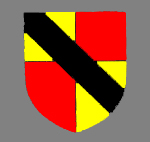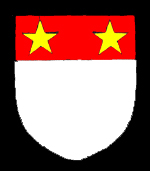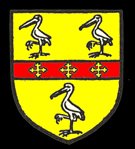The Manor of Keysoe Bury alias Keysoe Berrysted

Arms of the Barony of Bedford
Volume III of The Victoria County History for Bedfordshire published in 1912 gives details of the manors in Keysoe. Keysoe Bury can be traced to the holding of Hugh de Beauchamp, later Baron of Bedford, in the Domesday Book of 1086. John de Beauchamp was killed fighting for Simon de Montfort against King Henry III (1216-1272) at the Battle of Evesham in 1265. His possessions, including the Manor of Keysoe Bury, were to be divided between his heirs, his three sisters.
Keysoe Bury passed to John’s sister Ela, wife of Baldwin Wake. She left three daughters s her co-heirs, Ida de Steynegreve, Elizabeth de Hoobury and Joan Picot, who later married Ralph Paynel. The three parts of the manor then had histories as follows. The Manor of Keysoe Bury passed to Ida and was then inherited by her daughter Isabel, wife of Sir Simon de Patishull and later of Walter de Teye.

Arms of the Saint John family
Isabel’s heir was her son John de Patishull who still held the property in 1346. His son William died in 1359 and left three sisters – Sibil, Alice and Katherine, Keysoe being devised to Sibil, wife of Roger de Beauchamp, who died in 1380. The manor then remained in the Beauchamp family until Margaret Beauchamp married Oliver Saint John of Bletsoe. He died about 1482 and Margaret died in 1483, the manor descending to her son John Saint John.

Arms of the Crawley family
The manor remained the property of the Saint Johns of Bletsoe until the first years of the 18th century when it passed to Edward, Baron Harley, later 2nd Earl of Oxford and Earl Mortimer. In 1719 he alienated the manor to Jeremiah Sambrook. On his death a portion of the manor passed to the Crawley family of Stockwood, who held the manor into the 20th century. A succession of law of Property Acts in the 1920s effectively abolished manors in all but name.